Contact Center
.
Description and significance of the property
The Dilmun Burial Mounds represent unique sepulchral testimony to the Early Dilmun civilization over a period of about 300 years.
As remains of settlements are scarce and buried under thick layers of soil, the Dilmun Burial Mounds are the most extensive and most apparent evidence of the Early Dilmun culture. At the time, the newly gained prosperity allowed the island´s ancient inhabitants to develop an elaborate burial tradition applicable to the entire population. The excavated mounds provide a cross section of various social groups in the Early Dilmun society with thousands of individuals of different age, gender, and social class. They also offer crucial evidence on the evolution of elites and ruling classes. The ancient inhabitants of Bahrain understood the special geological configuration of the island and used less fertile lands for the formation of these extraordinary cemeteries. Ultimately, they built the biggest and densest burial mound cemeteries the world has ever seen.
The evolution of the Early Dilmun civilization is best reflected in the architecture of the Dilmun Burial Mounds. Four different mound types give clues about the emergence of social hierarchies. Even though the burial mounds can be divided according to variations in size and interior design, the basic layout of the mounds remains the same throughout the 300-year period. The construction typology is exceptional. The majority of the tombs were constructed as singles-toreyed small cylindrical towers while some of the bigger two-storeyed examples were built in a ziggurat-like shape. A very particular and unique characteristic of the Dilmun tumuli construction is the presence of alcoves. Depending on the tenant’s social status there can be up to six of such alcoves which were usually filled with mortuary gifts.
MADINAT HAMAD 1 BURIAL MOUND FIELD (BURI)
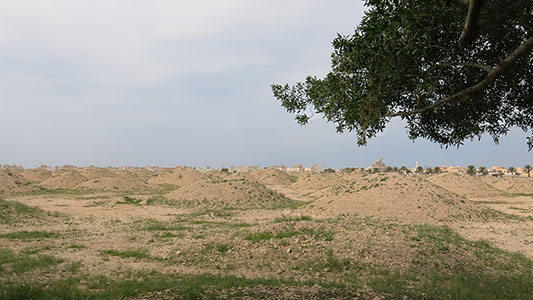
Madinat Hamad 1 Burial Mound Field (Buri) features 754 heterogeneous burial mounds including several children’s graves.
The cemetery also hosts the best example of a yet unexcavated burial mound with subsidiary burials; a major tumulus that was extended by several smaller ones, presumably, to host close family members.
MADINAT HAMAD 2 BURIAL MOUND FIELD (KARZAKKAN)
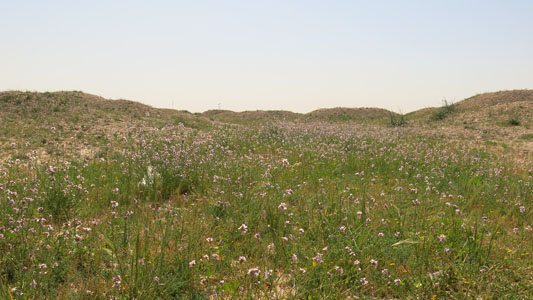
Madinat Hamad 2 Burial Mound Field (Karzakkan) is the second largest of the fields including 4,262 burial mounds set in a pristine wadi landscape. The majority are Late Type burial mounds; the field also features several transitional mounds.
MADINAT HAMAD 3 BURIAL MOUND FIELD (DAR KULAYB)

Madinat Hamad 3 Burial Mound Field (Dar Kulayb) represents the southernmost highest concentration of Late Type tumuli. A high level of homogeneity characterizes this cemetery. The 1,331 Late Type burial mounds show only slight variations in size and appearance, with few exceptions.
JANABIYAH BURIAL MOUND FIELD
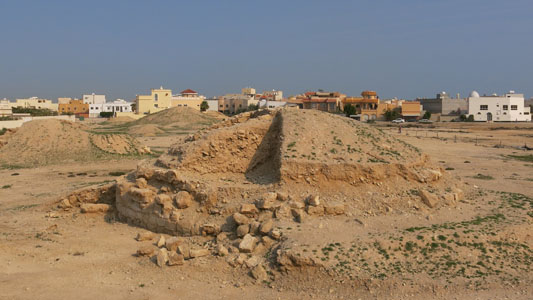
Janabiyah Burial Mound Field is a relatively small field. Apart from 13 Late Type mounds, the field contains 5 large, two-tiered chambered chieftain mounds which constitute the transition phase between the burial mounds of the populace and the royal mounds.
A ´ALI EAST BURIAL MOUND FIELD
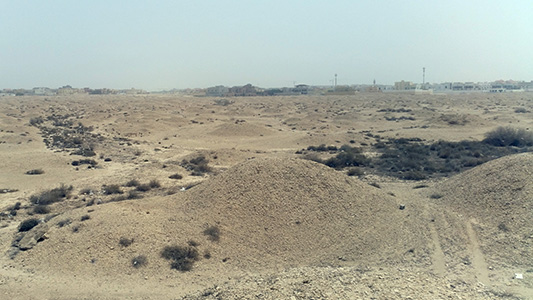
A´ali East Burial Mound Field is the largest cemetery counting 4,669 single burial mounds. It primarily features Late Type tumuli. Several royal mounds or what is assumed to be their forerunners are located in the northernmost part of the mound field.
A ´ALI WEST BURIAL MOUND FIELD

A´ali West Burial Mound Field is the western continuation of A´ali East Burial Mound Field counting 723 burial mounds. It comprises six special type burial mounds with outer ring wall. This rare type marks an important stage in the burial construction of the Early Dilmun elite.
A’ALI ROYAL MOUNDS
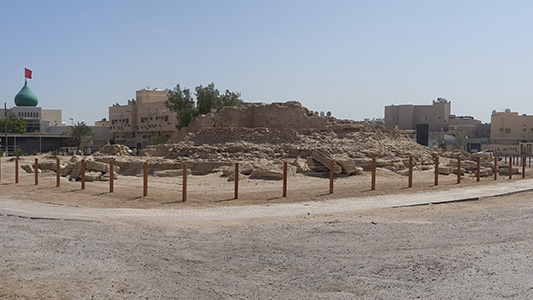
Royal Mounds 1 to 17 comprise 15 components; 13 single royal mounds and two pairs of royal mounds. They all display a distinctive architectural pattern while some of the excavated mounds show unique characteristics which allow for better understanding of the evolution of these grand burial monuments. A small number of these
royal mounds are not excavated and provide excellent conditions for future research, yet to be conducted.







